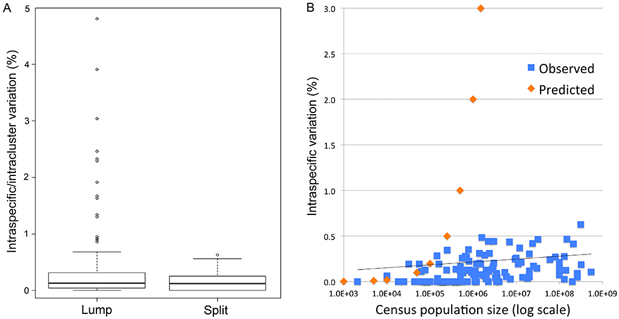This evening at the Old Whaling Church in Edgartown MA Jesse Ausubel will give a talk on “Meat & Potatoes and the American Landscape.” Young reporter Nathaniel Horwitz prepared a good story for the Martha’s Vineyard Times anticipating the talk.
Blog
Goldstone interview
On 7 July 2014 Jesse Ausubel was interviewed by Heather Goldstone in her public radio program “Living Lab.” A short article describes the interview, which focused on questions of land use and land cover, and links to the hour-long podcast.
DNA barcoding effectiveness supports a new view of how evolution works
In July 2 PLOS ONE article, “DNA barcoding works in practice but not in (neutral) theory,” David Thaler and I argue a radically different view of how evolution works, as compared to the standard neutral model, is needed to account for the widespread pattern of limited variation within species and larger differences among that underlies the general effectiveness of DNA barcoding. The following text is adapted from the article.
Fig. 1 (from PLOS ONE article). Intraspecific variation in birds is uniformly low across 100,000-fold differences in census population size. Apparent outliers reflect lumping of reproductively isolated populations.
“To to better understand the limits to DNA barcoding and the evolutionary mechanisms that underlie the usual barcode gap pattern, we used birds to test whether differences within and among species conform to neutral theory, the reigning null hypothesis for mitochondrial sequence evolution. We analyzed apparent barcode gap exceptions in detail–those with unusually large intraspecific differences and those lacking interspecific differences.
From a practical point of view exceptions may help define limits to COI barcodes as a marker of speciation. In the context of evolutionary theory, exceptions may give valuable insight into the mechanisms controlling variance within and among species. Birds are uniquely suited this task: they are well represented in barcode libraries, have the best-known species limits of any large animal group, and, most critically, are the only large group with known census population sizes, a key parameter in neutral theory.
Neutral theory predicts intraspecific variation equals 2 Nµ, where N is population size and µ is mutation rate per generation. Although textbooks and scientific reports recognize a multitude of exceptions to this predicted relationship, deviations are subsumed under the rubric of “effective population size” and accounted for by ad hoc modifications to the theory, which is assumed operative.
Here we harness the unique resources of avian barcode libraries and census population data to look at the question the other way around, namely, do the empirical data show any signature of variance proportional to population size? If not, does the observed range of variation fit with commonly proposed modifications to neutral theory? In addition, we examine whether molecular clock measurements conform to neutral theory prediction that clock rate equals µ.
This is the first large study of animal mitochondrial diversity using actual census population sizes and the first to test outliers for population structure. We demonstrate uniformly low intraspecific mitochondrial DNA variation in birds regardless of population size. Nearly all apparent exceptions reflect lumping of reproductively isolated populations (many of which represent distinct species) or hybrid lineages. To our knowledge, this is the first large test of neutral theory applied to mitochondrial diversity using actual census population measurements rather than crude proxies of population size such as phylogeny or body weight, and the first to test outliers for population structure.
In contrast to prior analyses, we find uniformly low intraspecific variation regardless of census population size. Universally low intraspecific variation contradicts a central prediction of neutral theory and is not readily accounted for by commonly proposed ad hoc modifications. We conclude that this finding together with the molecular clock phenomenon are strong evidence that neutral processes play a minor role in animal mitochondrial evolution.
We argue a radically different view of evolution–extreme purifying selection and continuous adaptive evolution–is needed to account for the widespread pattern of limited variation within species and larger differences among that underlies the general effectiveness of DNA barcoding.”
I hope you enjoy!
Plos One paper – Practice not Theory
Peak Farmland and Potatoes
We post Peak Farmland and Potatoes, Jesse Ausubel’s Plenary address to the 2014 Potato Business Summit of the United Potato Growers of America, San Antonio, 8 January 2014.
Rockefeller #1
We share in the pride of everyone at The Rockefeller University that it ranked #1 in a recent survey of the impact of research of 750 universities around the world.
Cars and Civilization
As part of the William and Myrtle Harris Lectureship in Science and Civilization, Jesse presented a lecture entitled ‘Cars and Civilization‘ at the California Institute of Technology on 30 April 2014.
Science Saturday May 3 2014
Kate Stoeckle (Sushigate–How We Became DNA Detectives–You Can Too!) and Mark Stoeckle (Citizens Help Study Icky and Mysterious City Pest–Cockroaches) showcased their work on May 3 at Rockefeller’s first “Science Saturday” which attracted 740 people including 375 children to view many wonders of science practiced by Rockefeller researchers.
Liberazione dell’Ambiente at Amazon
Jesse Ausubel’s autobiography, La liberazione dell’ambiente, is now available at Amazon Italy and on sale in bookstores throughout Italy. Here’s a photo of Jesse with publisher Sante di Renzo, editor Maria Pia Felici, and the designer of La liberazione dell’ambiente, with photos of copies on sale in bookstores in Rome and Florence May 2014
DNA barcoding and taxonomy’s future
Mark Stoeckle is interviewed by Jenny Marder for PBS News Hour on DNA barcoding and taxonomy’s future
